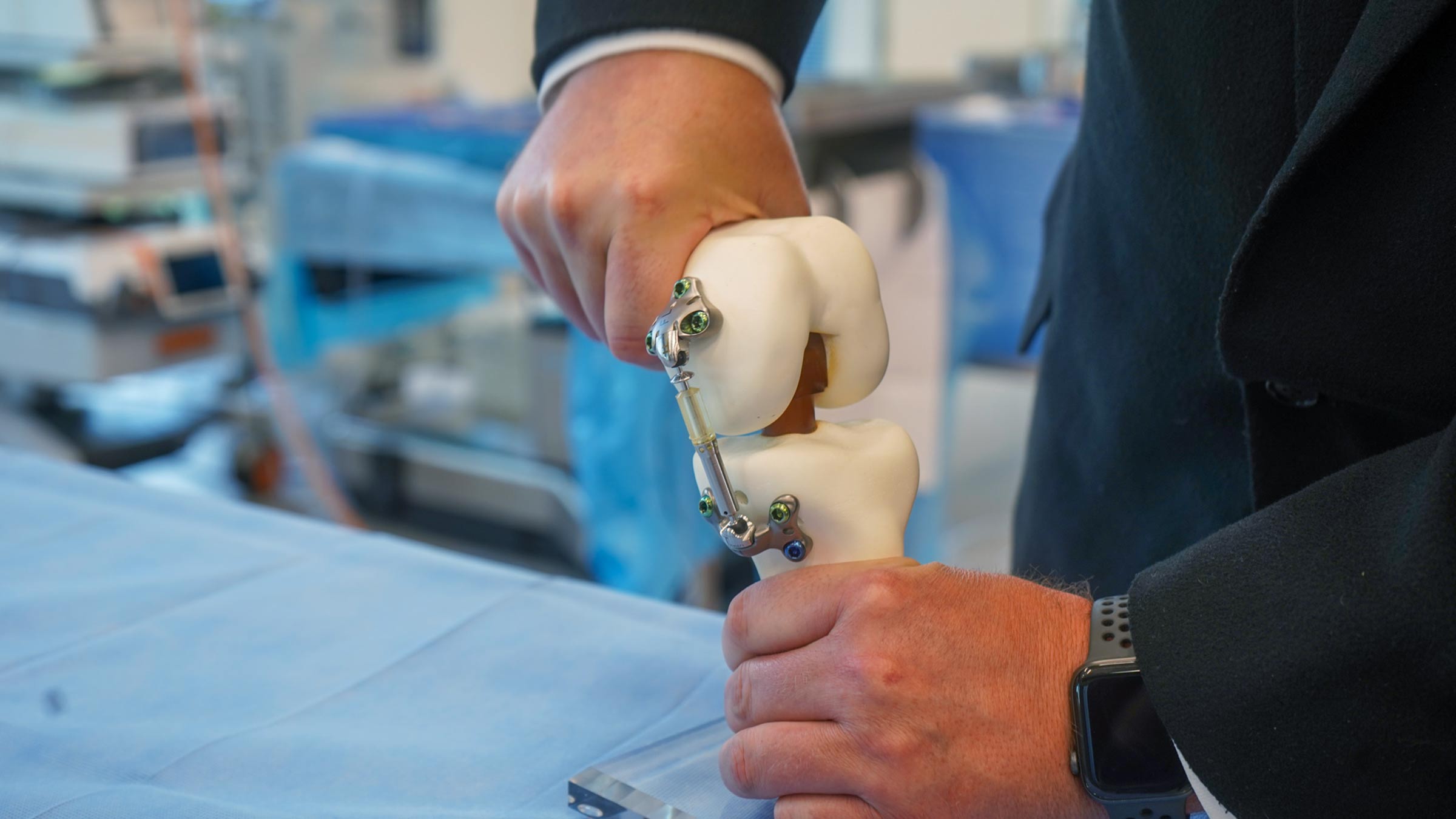FDA-approved MISHA knee system offers new knee replacement alternative
For years, people with osteoarthritis in their knees had limited treatment options.
Orthopedic doctors could offer only conservative treatment options, such as weight loss and physical therapy, or drastic surgery for a total knee replacement to ease painful symptoms.
There was no alternative for patients wanting to postpone a major knee surgery to bridge their active lifestyle to a minimally invasive surgical option.
That recently changed, thanks to a U.S. Food and Drug Administration-approved device used in a clinical trial at The Ohio State University Wexner Medical Center in 2018.
“It's a revolutionary implant for people who have mild to moderate osteoarthritic changes in the medial compartment of the knee,” says David Flanigan, MD, an orthopedic surgeon specializing in knee injuries and a clinical professor of Orthopaedics at The Ohio State University College of Medicine.
How the MISHA knee system works
MISHA, which stands for minimally invasive subchondral hemi-arthroplasty, is a shock absorber that can ease joint pain by about 30% and increases functionality for patients by 90%.
“It's a plate that's attached to the femur and a plate that is attached to the tibia. In between, it has a shock absorber very similar to what you see in a car," says Dr. Flanigan, director of the Cartilage Restoration Program at the Ohio State Wexner Medical Center, gesturing to the spring on a model. “As you’re weight bearing, what happens is that this takes about 30 to 40 pounds of pressure off of your medial compartment of the knee.”
What arthritis does to knees
Osteoarthritis happens when tissues in the joint degrade over time. Common symptoms include stiffness and soreness. The condition is most common in those who have sustained injuries, overused joints and can happen because of aging.
An estimated 40 million Americans suffer from osteoarthritis, half of which are under the age of 65. Many want to postpone knee replacements, which would change the structure and integrity of their knee.
Who is a good candidate for the MISHA knee system?
“This is really for people who have mild to moderate arthritic changes on the inner portion of the knee,” Dr. Flanigan says. “It's not for people who have end-stage arthritis or complete bone-on-bone arthritis. That's a better treatment for a knee replacement.”
The device, made by Moximed, is placed under the skin but doesn’t structurally change the joint or take away any surgical options in the future.
It's unclear how long the implants will last, but results have been promising.
“The MISHA knee system has been in development, and it's been through multiple clinical trials in different reiterations of this device,” Dr. Flanigan says. “Now that it’s FDA-approved, I think you can feel confident that this is realistically a good option for you.”
Ohio State’s role in developing MISHA
The Ohio State Wexner Medical Center was one of 10 clinical sites in an international trial that began in 2018.
The trial had 81 participants across all sites.
Ohio State, which had 10 participants, was the site of the first MISHA surgery in the country, completed by Dr. Flanigan.
“It’s changed so many patients’ lives for the better,” he says.
Chuck Stenger, a retired firefighter, was the first person to receive the shock absorber device in 2018.
“I was told I was probably a candidate for a knee replacement, and I didn't think I was quite ready for that yet,” Stenger says. “Three days after the implant procedure, I was walking around, and with a little therapy I’m back to golfing, taking long walks and just living life without constant pain in my knees.”
A midway point before a full joint replacement
Stenger, like many patients experiencing osteoarthritis pain in their knees, hopes to postpone a complete knee replacement.
“A lot of patients out there have arthritic changes and are really in this middle zone of trying to accommodate their symptoms over time and trying to delay the need for a knee replacement,” Dr. Flanigan says. “Everything we are trying to do — whether it's injections, physical therapy or even other surgical treatments — it’s trying to improve their function and decrease their pain.”
MISHA’s effectiveness
The shock absorber had a success rate of 86% compared to the most common procedure, high tibial osteotomy, which has a success rate of 66% and is typically used to treat symptomatic osteoarthritis of the medial compartment of the knee, according to the study.
The shock absorber doesn’t do anything while you’re sitting, but while you’re active and walking, it takes a lot of pressure off the inside portion of the knee, Dr. Flanigan says.
What Ohio State is continuing to do for knee pain
Ohio State participates in numerous clinical trials that center around cartilage and arthritic changes in the knee.
“We are on the cutting edge, bringing the newest technologies to our patients to help them restore function and get back into the game,” Dr. Flanigan says. “We’ve been involved in multiple clinical trials in bringing the best, most up-to-date clinical practice to you as a patient. I think that's what you want when you’re looking for a surgeon is to make sure that you are seeing people who are truly experts.”

Ready to stop the pain?
Schedule an appointment with one of our orthopedic experts.
Get started







